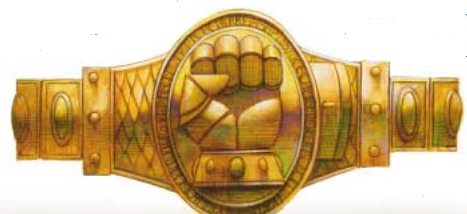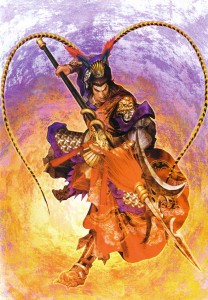Yunshan has had four very different sets of rulers or Dynasties as the scholars like to call them. Under each dynasty, Yunshan was a very different place. Much of Yunshan’s culture results from the way these four dynasties effected its people.
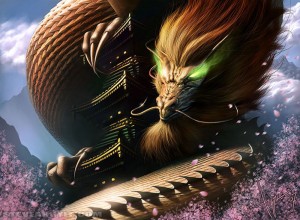 The Huizhou Dynasty (???- 0 AB)
The Huizhou Dynasty (???- 0 AB)
The Original people of Yunshan were called the People of the Mists. Legends say they were refugees, fleeing some great cataclysm that had destroyed their homeland. They discovered the ancient white roads, and followed them into Yunshan. They were human, 5 to 5 1/2 tall, pale skinned with almond shaped eyes of green or blue, and high cheek bones. In Yunshan they left behind the ways of their past, spreading through the mountain valleys and returning to a way of life closer to nature. Yunshan’s spirits embraced them. Chief among these spirits were the mysterious Huizhou (Hoy-Zow)
These powerful spirits lived in monasteries high in the mountains. The People of the Mist worshiped them like gods. There’s much debate about what the Huizhou were. In the most popular legends they are depicted as tall, gracefully built, blue skinned men with fierce features and monstrous horns, who could turn into dragons. Each of Huizhou was a unique master. Some were benevolent protectors of the mist people. Some were aloof and detached overlords who rarely helped and rarely made demands. Some were said to be cruel and tyrannical. The People of the Mist lived in their valleys beneath the Huizhou for many many centuries.
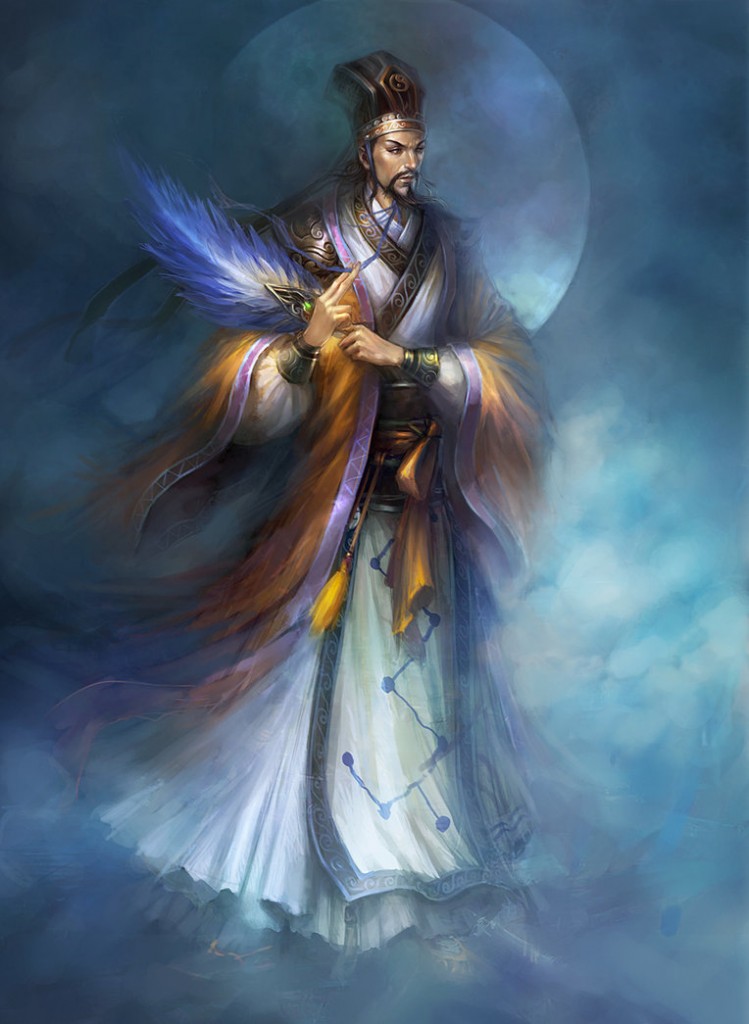 The Tein Ming Dynasty (0- 600 AB)
The Tein Ming Dynasty (0- 600 AB)
The Huizhou slowly vanished. Their monasteries became abandoned places of mystery most dared not explore. No one knows why they left, but scholars love passionately debating the theories. Whatever the cause, not long after their disappearance another people appeared in Yunshan. Tein Ming was a massive globe spanning empire, and Yunshan was one of the last places it’s wizard ambassadors visited. To the People of the Mists, the Tein Ming seemed like gods that came from the sky, just as powerful as the Huizhou they once served. The Tein Ming offered to teach the people of the mist the ways of magic and advanced society if they would peacefully become a part of the Tein Ming empire. In time, the humble and meek people of the mists submitted to the rule of the Tein Ming.
Hundreds of years passed. The Tein Ming moved into Yunshan. They built temples to their gods and beautiful cities. They terraced the steep valleys and built irrigation for farming. They built schools, fortresses and libraries. In all of this, they included the people of the mists, not just bringing them into their empire, but making them a part of its culture. After a few hundred years the two peoples were completely assimilated. Yunshan became the Province of Yunshan , one of the most beautiful and mysterious provinces among hundreds in the vast Tein Ming Empire
Empires fall. A gigantic rebellion broke out. It seems the Arcanocracy that ruled Tein Ming had become detached and uncaring of the peoples needs. Kings and priests led the rebellion and a great multitude of citizens and orders joined in the fight to throw off the emperor and empress. The final years of that decades long struggle were fought in Yunshan, where the rebel armies of many nations swept in to fight the last loyal forces of the empress Leioki. Though her armies were weakest at this point, she and her wizards were at their strongest, having reached new heights of depravity in the name of magical power. The battles of those final years changed Yunshan forever. They are legendary.
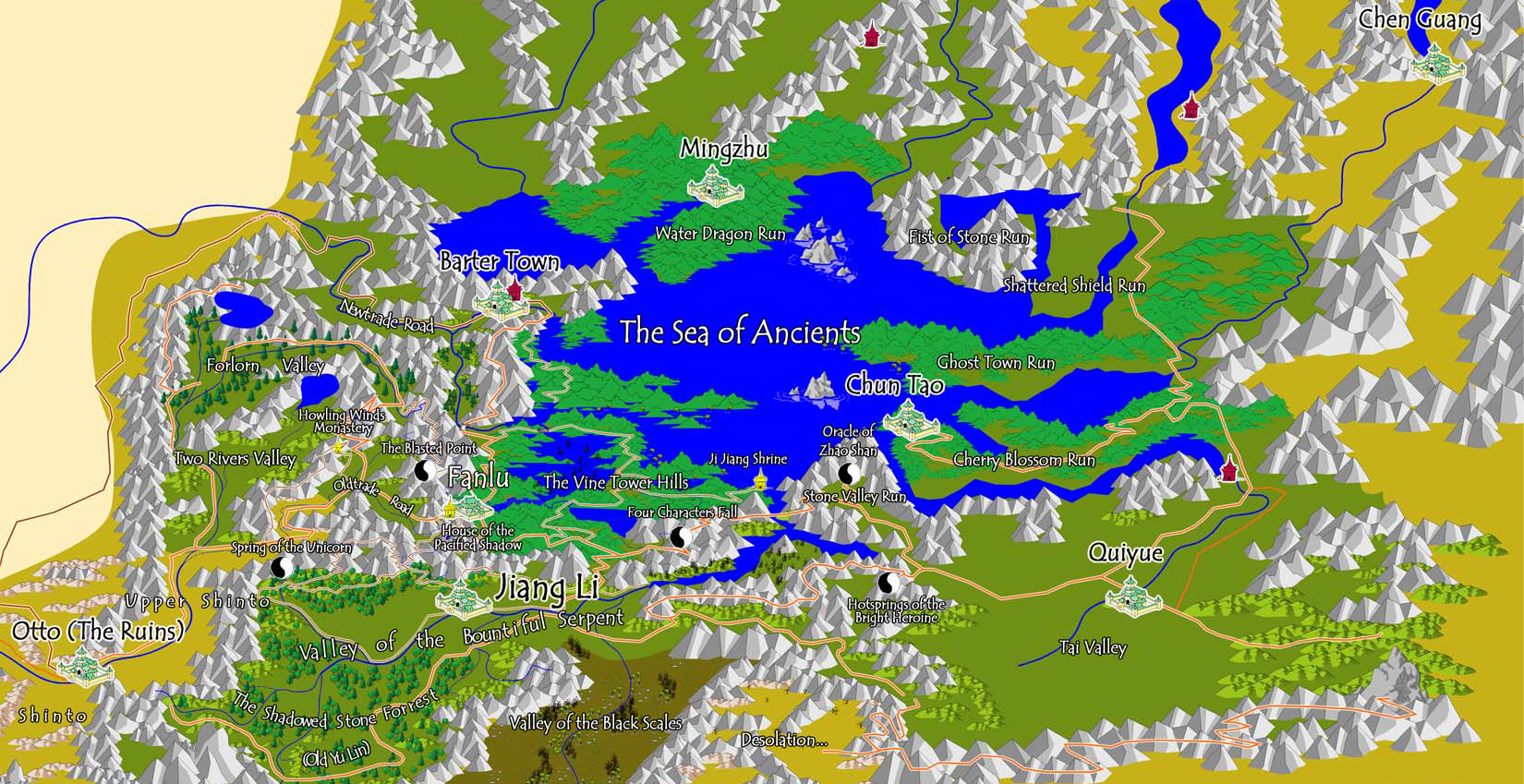
Here is an overview of Central Yunshan. The map is about 360 miles across, not a huge area, but huge enough if traveling across it by land! I’ve focused on the big things. Settlements: 5 of the 6 clan capital settlements are noted, along with the biggest nozufoo settlements, Fanlu and Barter Town, and the largest nearby outside city, Otto. Temples and Shrines: Yunshans Four Great Temples are noted as the reddish-purple pagodas. Their names are not yet added, but the one right next to Barter Town is the Temple of the Mists. Also, a few important shrines have been noted as yellow pagodas: The House of Pacified Shadows, the Howling Winds Monastery, and Ji Jiang Shrine. Known Holy Sites and Shines: Noted as the Ying Yang symbols. The Blasted Point, Unicorn Springs, Oracle of Zhao Shan, and Four Characters Fall are noted. Finally, all the major valleys/regions are noted so you can find The Two Rivers Valley, or The Vine Tower Hills. If every shrine, village, and mountain range on this map were named it would be a mess of tangled text. This is just a good reference to know where things are. Rest assured there is much more detail hidden close up, plenty to explore.
The Empress and her loyalists fell. Most of the rebel armies left Yunshan and returned to their far off homes. Many raced back to the center of the empire to fight over who would be the new emperor, but the rebellion had irrevocably shattered the empire, and it split into a thousand warring kingdoms. Some of the rebel generals stayed in Yunshan. They did not care to try for the empire, nor return home to the ungrateful kings who had sent them to war. The future was uncertain, anything was possible. These were the days of legend, and in this new world of uncertainty, many of the rebellions leaders wanted to make kingdoms of their own. Yunshan was the most beautiful land they had passed through, and ripe for the taking.
For many more years rebel generals, most from far off lands, fought over Yunshan, while its poor people kept their heads down and tried to rebuild from the last war. A charismatic general from a place called Shin, known to be fearless, decisive, tough and fair, rose to the top. Shin looked like he might become king of Yunshan, and over time he won the support of Yunshan’s natives more and more. They were tired from decades of war and happy that this general seemed like a promising leader. Year by year, more and more villages and factions got behind the would be King. With the support of the native people of the mist, general Herot of the Shin soon drove off or assimilated his rivals and became Yunshan’s first king.
The Shin Dynasty
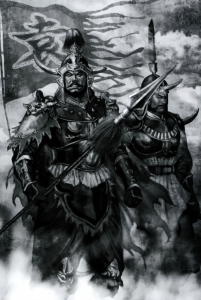
The Shin were master warriors, they brought their rule to Yunshan, but kept in place the Tein Ming bureaucratic system. As a result their transition to rule went smoothly. They did not try and impose their own system, but ruled Yunshan much as it had always been ruled. To the people, the first 5 decades of Shinto rule were an improvement on how things had been, and felt like “getting back to normal”
This General Herot, took on the name Shinto to honor his peoples victory, and his time became known as the Shinto dynasty, or the time of the Shinto Kings. The Shin people were stocky and sturdy, whether tall or short. They had brown and black hair, brown, green or hazel eyes, and complexions of from olive to brown.
Under the Shinto kings the native people of Yunshan became 2nd class citizens. The Shinto held all the places of high power and were allowed privileges the others were not. Still, as 2nd class citizens go, the people of the mist really didn’t have it all that bad. The Shinto kings retained the good technologies of the Tein Ming. They rebuilt the irrigation canals and damns ravaged by neglect and war. They honored the temples and shrines. Wizards and powerful magic was blamed for much of the terrible changes the land had undergone through the years of war, and King Herot disbanded all of Yunshan’s arcane orders. The people loved this, seeing him as a bold protector. As overlords, the Shin occupiers played nice, and brought Yunshan close to the glory it had known under the Tein Ming.
But eventually, a bad ruler came. A selfish, greedy, little turd took the throne, and within 20 years there were whispers of an uprising. A group of unrelated mystics and heroes began to earn the favor of the common people and all of them spoke of a Free Yunshan. Each gained a cult following among the subjugated people of the mist. They preached of a Yunshan that could finally be free to rule itself. They preached that the Shin had to go! These charismatic heroes led a long rebellion against the Shinto, the Guided Rebellion, and history would know them as the Guided Guides. Eventually the great temples of Yunshan sided with the people against the Shin. These were old and powerful religious orders that had survived the Tein Ming rebellion and become a pillar of Yunshan society. Each wielded political power in their region, and each could field a small army of temple guards. Their influence and marshal might was matched only by the Shinto Kings themselves, and with the arcane orders disbanded long ago, they were the preeminent wielders of magic. The Shin lost the support of the People of the Mists, then they lost the magical support of the temples, and they had long ago disbanded any arcane orders of wizardry they might look to for support. After years of rebellion, and many battles, the Shin were forced to abandoned Yunshan, fleeing in a great mass of humanity down the Oldtrade Road. The Rebels dealt them many horrid blows along the way, making it clear they should never come back.
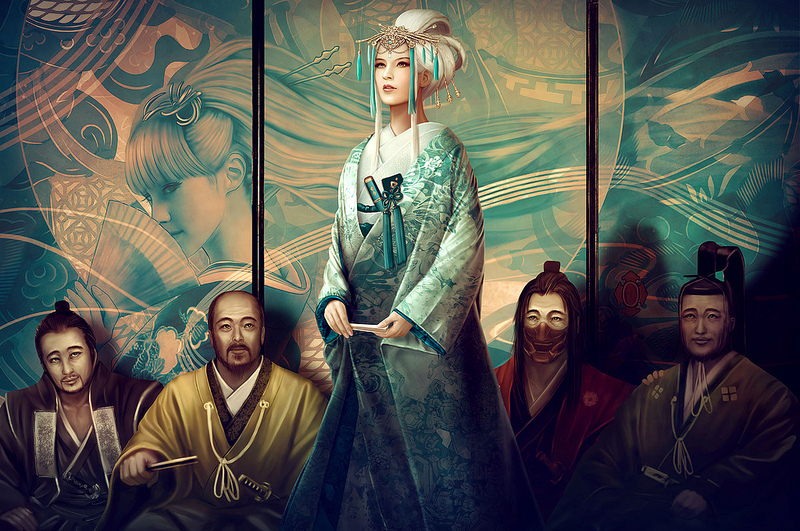
The Council of Final Reckoning divided the land between the 6 guided guides and their followers. It established the Four Great Temples as autonomous agents of the Heavens, and Established the Ten Orders Dynasty.
The Ten Order Dynasty
The leaders of this new rebellion were many, the so called Guided guides, Yunshan’s four great temples, and many other great leaders who had risked everything to rise up against the Shinto. A council was formed to decide the future. Each of the Guided Guides was there, as well as representatives of the four great temples and many others. For years they debated how the new Yunshan should be run. The current order eventually arosefrom these meetings, which became known as the Council of Final Reckoning. At length, this council came to the following decisions:
–The Four Great Temples were allowed to keep dominion over large areas around them.. They would each be independent, serving only the gods, and would never again be subservient to a mortal king.
-Each of the Six Guided Guides was to return to the part of Yunshan they were from and set up a government. Long ago the Tein Ming had divided up Yunshan into 6 regions and set up highly organized bureaucracies to govern each. The Shin had kept these systems of order in place, and the newly freed people of the mist saw no reason to abandon them. These organizations seemed as much a part of Yunshan culture as any tradition, and had always brought them order and prosperity. Once again, the well laid bureaucracy the Tein Ming had first hundreds of years ago, not only survived rebellion, but allowed the smooth tranfer from one set of rulers to another. Each of the six newly re-formed regions would be ruled by the families that had distinguished themselves in the rebellion, and these families would form into a clan. Rulership would be by a council of the families with one lord elected as a figurehead and general. The new Yunshan would be divided into 10 regions, Four run by the great temples, each with their own small theocracies, and six other regions, each ruled by one of the newly formed clans. Each clan kept the Tein Ming and older Mist People traditions alive, but each had it’s own twists on how to govern itself.
-A pact was made that war would be outlawed. Zones of wilderness were established between the clans where they were never to expand into. Future disputes would be solved by the Council of Final Reckoning. The disputes would be settled with decrees, or by honor duels, as the council saw fit. This council existed only to mediate clan disputes, not to serve as a central government. There would be no overreaching government in Yunshan, only independent and regional powers.
-There were many people who had stayed loyal to the Shin Dynasty right up to the moment it’s last king fled. One of the most contentious topics at those post rebellion councils was what should be done with these people? Exile, drive them out with fire and sword, forgive them and take them in…? Finally the choice was to establish a new caste of people, the Nozufoo, cast out of “real” society for what they had done. They would not be allowed to own land or build settlements in the newly formed clan and temple lands. Further more, they were not allowed to stay in the clan lands in any one place for more than one night. These thousands had few choices, none of them great.
Some left Yunshan altogether, wishing to leave a land that no longer welcomed them. Most found the world beyond Yunshan’s high mountains, that had risen out of the ruins of the Tein Ming Empire, was a far worse thing.
The clans left broad swaths of Yunshan’s wilderness unclaimed, forever considered off limits to their ambitions. Here, in the remote valleys and dense forests, those brave enough could make a life. Some built settlements and tried to live good lives based on humility, hard work, and coexistence with the spirits of the land. Some organized themselves into bandit clans, and became the bitter enemies of those who cast them out.
There were huge areas, some with established and thriving settlements, That lay within Yunshan, but outside of the the newly formed clan lands. The clans people considered these places, once the final strongholds of the shin, cursed and undesirable, too close to the outside world and plagued by the restless spirits of too many wars. Places like Bartertown became the last civilized refuge for nozufoo, that is, for those who could buy their way in.
Some chose to stay in the clan lands to live as gypsies. The clan lands were safe, even if they were unwanted and looked down upon there. Those who found this life found new purpose, as merchants within the clan lands. The Clans people saw merchant as a lowly job, yet it was necessary, and could be lucrative. It required constant travel, which the now gypsie-like Nozufoo had to endure anyways, so it was a logical fit.
The Division of the Land
The new leaders of Yunshan at the Council of Final Reckoning agreed that all the land would be classified as one of 4 things; Clan Land, Temple Land, Troubled Land, or No Mans Land.
Clan Land
The best parts of Yunshan, best for providing food, and least ravaged by war, were divided into six separate regions, each awarded to one of the newly formed clans. The clan lands are peaceful and idyllic expanses, where beautiful cities, ancient shrines, and quaint villages rise up in peaceful green valleys, with the majesty of breathtaking mountains as a backdrop.
Temple Land
Each of the four great temples of Yunshan controls a large chunk of good land, including the settlements and villages that stand there. These Temple lands are well ordered, well protected realms, small theocratic kingdoms in their own right. The people that live on these lands are exceptionally pious and religious, enamored with the temple order that rules over them. They owe their continued safety and prosperity to the loyal protection of the temples armed battalions of warrior-monks, and they often owe their exceptional health to the miracles performed daily by the temple priests. These people live lives surrounded by heavenly visions and divine miracles…they tend to live lives in a peaceful, awestruck admiration of the temple order they live in the shadow of. To them, the priests are living saints, the warrior monks agents of righteous heavenly judgement, and the demon hunters of the temple seem as angels on missions of heavens wrath.
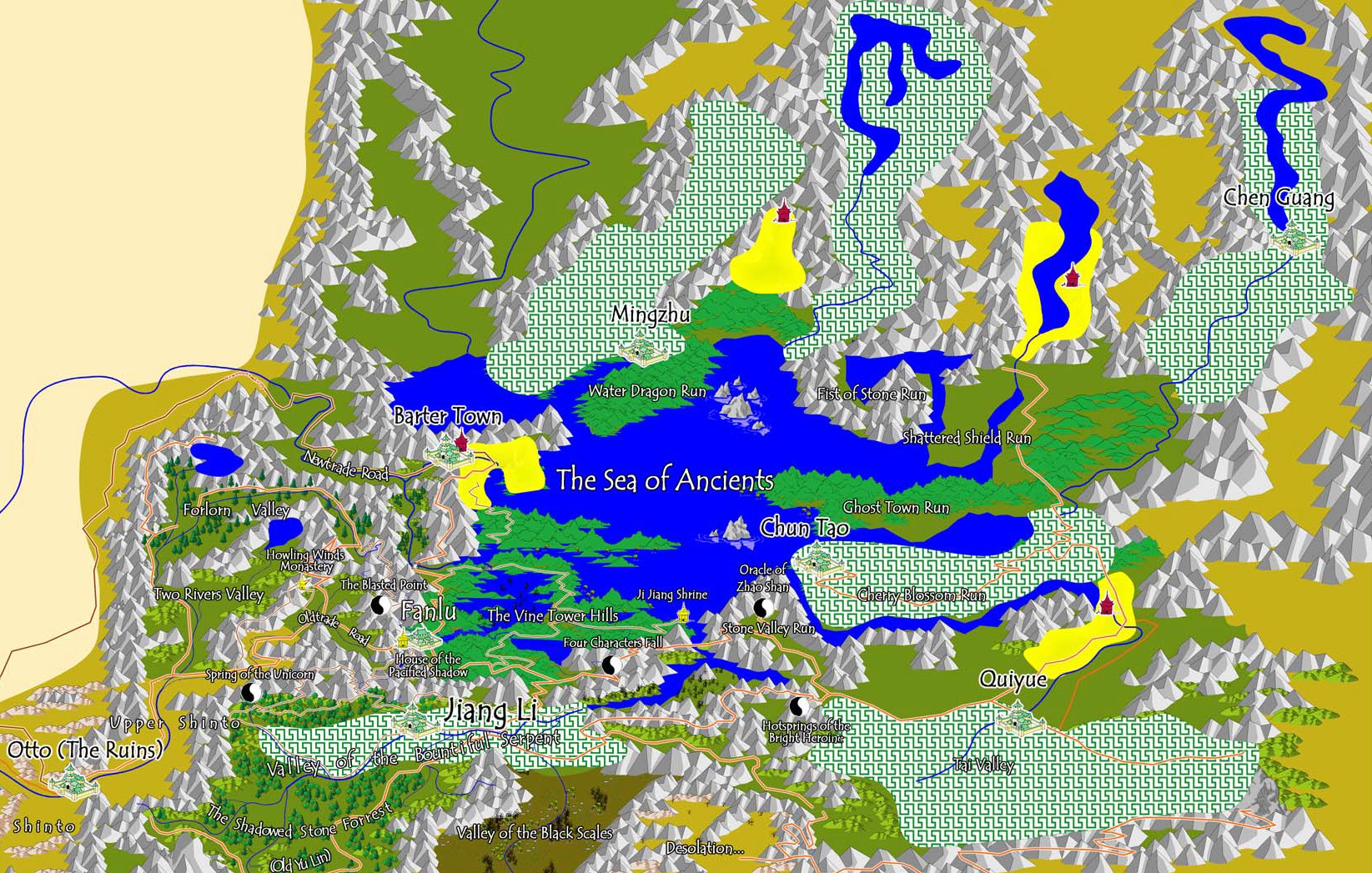
The Green Zigzaggety areas represent the Lands controlled by the Six High Clans of Yunshan. The Four yellow blobs are the areas controlled by Yunshan’s Four Great Temple orders. All the areas not covered are seen by the clans and temples as either wilderness (No Mans Land) or as Troubled Land. Just because the Clans see it this way, does not mean others do! There are other kingdoms that have risen up in the wilderness and troubled lands of Yunshan, but we shall learn more about them later.
Troubled Land
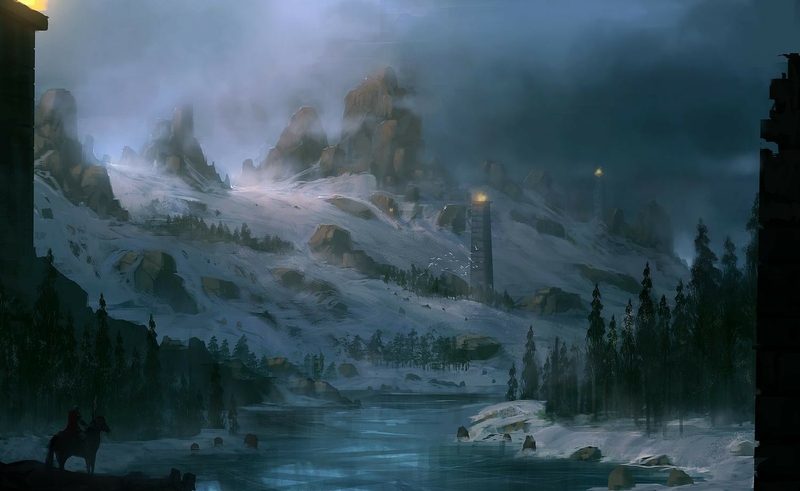 Once an untouched land, Yunshan lost it’s innocence, having seen the terrors of war and high magic play out across it’s lands. The Shu Ha rebellion, Leioki’s desperate last stand in Yunshan, the chaos that followed as the Shin came to power, and the chaos that renewed when the Guided Rebellion cast them out…all these things had taken their toll. In mystical Yunshan, such disturbances produced very real scars upon not just the surface of the land, but upon it’s soul. There were still areas devastated by the Shu Ha rebellion; Yu Lin, the great forested valley south of the Valley of the Bountiful Serpent, also the massive valley east of Quiyue, where Leioki’s palace had stood. There were also places devastated more recently by the Guided Rebellion; All the places where the Shinto had made their last stands, Lei Kun (present day Fanlu) and the surrounding Vine Tower Hills, the lands around the Oldtrade road, including present day Upper and Lower Shin, and Bartertown. The towns in these places had been razed and demolished…bridges broken, walls torn down, all in the final battles to break the
Once an untouched land, Yunshan lost it’s innocence, having seen the terrors of war and high magic play out across it’s lands. The Shu Ha rebellion, Leioki’s desperate last stand in Yunshan, the chaos that followed as the Shin came to power, and the chaos that renewed when the Guided Rebellion cast them out…all these things had taken their toll. In mystical Yunshan, such disturbances produced very real scars upon not just the surface of the land, but upon it’s soul. There were still areas devastated by the Shu Ha rebellion; Yu Lin, the great forested valley south of the Valley of the Bountiful Serpent, also the massive valley east of Quiyue, where Leioki’s palace had stood. There were also places devastated more recently by the Guided Rebellion; All the places where the Shinto had made their last stands, Lei Kun (present day Fanlu) and the surrounding Vine Tower Hills, the lands around the Oldtrade road, including present day Upper and Lower Shin, and Bartertown. The towns in these places had been razed and demolished…bridges broken, walls torn down, all in the final battles to break the 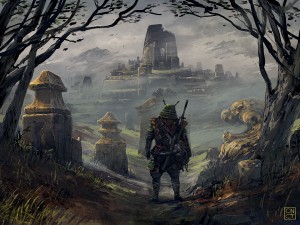 will of the Shinto King as he stubbornly fought back with murderous rage.
will of the Shinto King as he stubbornly fought back with murderous rage.
The Troubled lands had seen the greatest atrocities of Yunshans age of struggles. Many were believed to be cursed and haunted by the evils that had been committed in them. Many were poisoned by the aftermath of terrible magic, or plagued by ruthless bandit lords. The clans decided to abandon these lands, to name them as Troubled Lands, places no respectable person would want to live. Much of Yunshan’s Nozufoo and foreign population now live in these “Troubled Lands”, building lives for themselves in the bandit infested and often violent remains of Western Yunshan. These places are the only places the Nozu are allowed to build and settle with any safety, and safety here is never taken for granted, it must always be vigilantly protected. Nozufoo settlements and villages dot the lands the Clans people call “Troubled”.
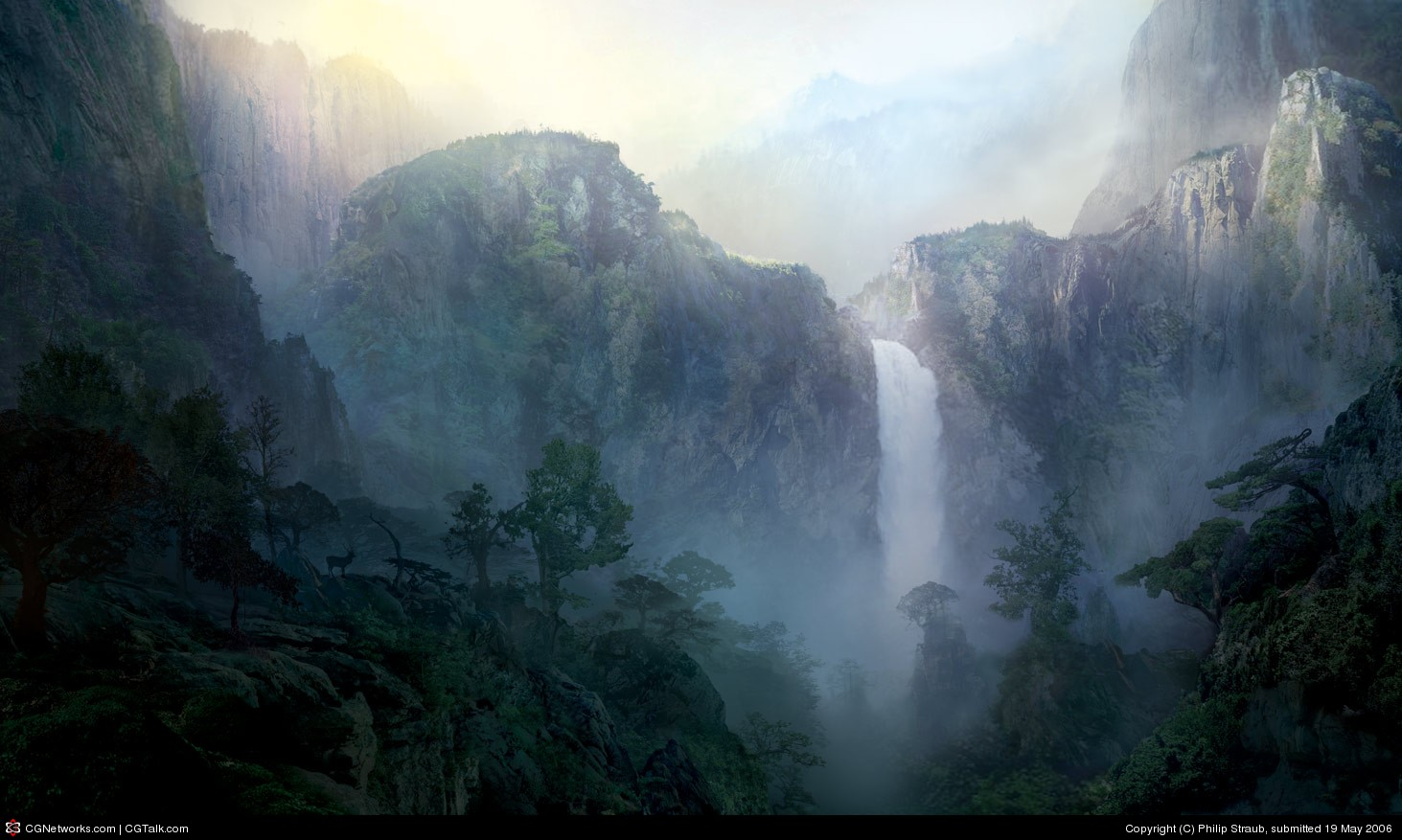 No Mans Land
No Mans Land
Wilderness, a place for the beasts and spirits. Broad swaths of wilderness remained between the six newly apportioned Clan lands. It was agreed these lands would be left as the dominion of spirits and wild beasts, places the clans agreed to leave off limits and never fight over. Some of these places once held human settlements, but most had been wild since men first came to Yunshan. Clans people view No Mans Land with great superstition, and like Troubled Land, they go there only on important missions. There are Nozufoo and other strange outcasts that live in the deep wilderness, but most have made pacts with the spirits of these places, becoming something other than men. Tribes, said to be born of the union of fey spirits and men, shape-shifters and lycanthorpes, men who change into animals, are said to live in these wild places. At best, the clans see these wild tribes as lost causes, men who have abandoned humanity, at worst, they are seen as abominations.

